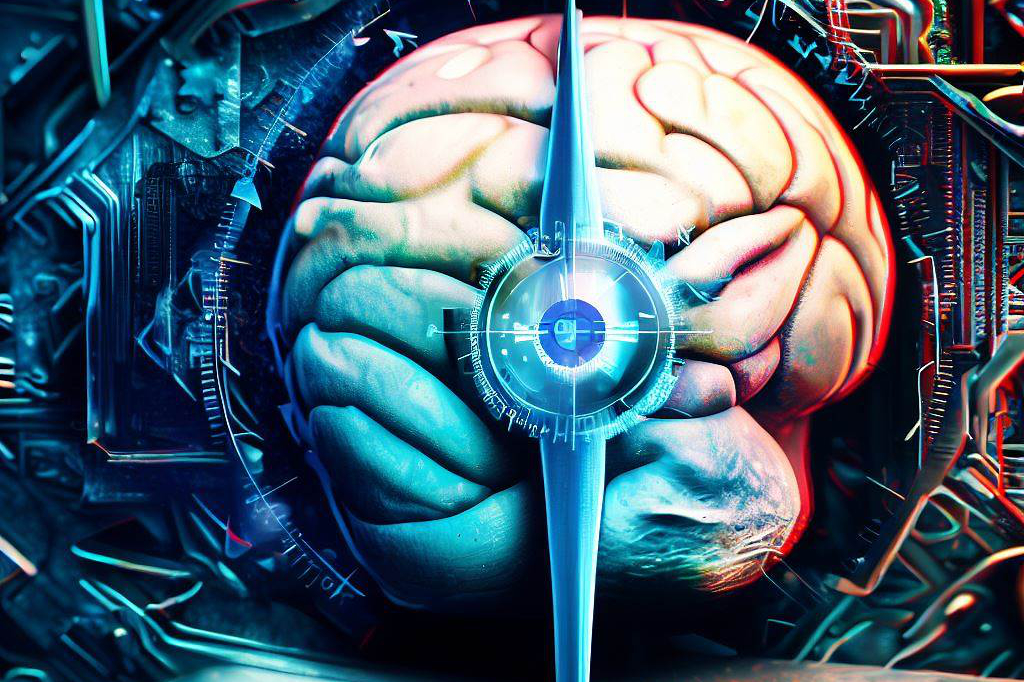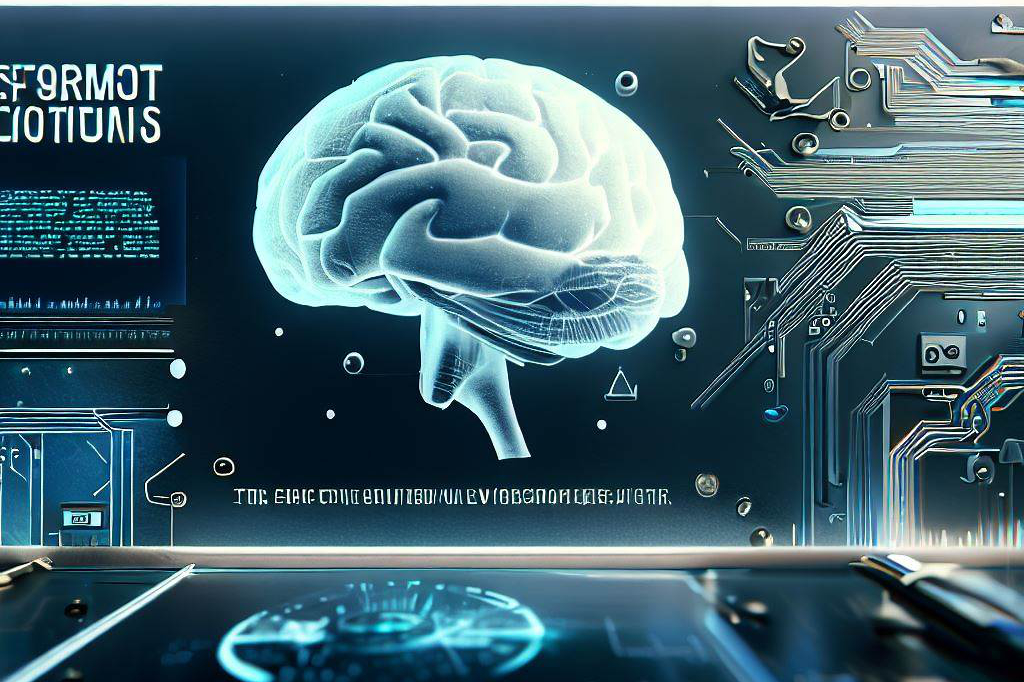The Age of Cyborgs:
Imagine a world where humans can control machines with nothing but their thoughts, where people can enhance their cognitive abilities, control prosthetic limbs, or overcome neurological disorders with the help of implanted devices called neural implants. Such a world may seem like science fiction, but it is becoming increasingly possible with the advancements in technology.
Neural implants are an emerging field that has captured the imagination of scientists and thinkers alike. They promise to revolutionize medicine, communication, and entertainment while raising new ethical questions about where to draw the line between human beings and machines.
What are Neural Implants?

Neural implants are electronic devices that interface directly with the central nervous system (CNS) or peripheral nervous system (PNS). They are designed to record, stimulate, or modulate neural activity in a controlled manner. The idea behind neural implants is to restore lost function by bypassing damaged nerves or tissues using electronic substitutes.
For example, they can be used to treat Parkinson’s disease by stimulating specific regions of the brain responsible for movement control. At the same time, they can also be used as an assistive device for people who have lost limbs or suffered spinal cord injuries.
Merging Man and Machine:
The concept of merging humans with machines has been around for decades in popular culture, from cyborgs in sci-fi movies to bionic superheroes on TV shows. However, it is only recently that we have begun making significant strides towards transforming this fantasy into reality.
With advances in fields such as neuroscience, engineering, and computer science – researchers have started exploring ways to merge biological systems with artificial ones seamlessly. The results could lead to unprecedented improvements in human capabilities, such as enhanced memory retention or improved sensory perception.
The growing interest in merging man and machine is driven by several factors. A significant reason for the interest in neural implants is the need to find new treatments for neurological diseases such as Alzheimer’s, epilepsy, and paralysis.
Additionally, there is a growing curiosity about using neural implants to enhance human capabilities beyond what is naturally possible. The potential applications of neural implants are vast and varied – from brain-computer interfaces that allow people to communicate without speaking to virtual and augmented reality experiences that immerse users in lifelike environments.
Neural implants are an exciting emerging technology that holds tremendous promise for improving human lives. They represent a significant step forward in merging man and machine, opening up new possibilities for medicine, entertainment, and communication.
However, as with all technologies that blur the line between biology and artificial intelligence – there are ethical issues surrounding their use that require careful consideration. In subsequent sections of this article, we will delve deeper into the science behind neural implants, their potential applications, ethical concerns around their use, as well as future developments in the field.
The Science behind Neural Implants
Neural implants, also known as brain implants or neuroprostheses, are electronic devices that are surgically implanted into the brain or nervous system to stimulate, record, or modulate neural activity. These devices can be used to treat a variety of neurological conditions and have shown potential in enhancing cognitive abilities, such as memory and attention.
The basic function of a neural implant is to interface with neurons in the brain and/or nervous system. This is achieved through the use of electrodes that can either record neural activity or deliver electrical stimulation to the brain.
The process begins with an incision being made in the scalp before drilling a hole into the skull to reach the targeted area of the brain. The electrode array is then carefully inserted into this area.
Once properly placed, electrical signals can be sent through these electrodes to stimulate specific areas of the brain or record its activity. There are several types of neural implants currently being used, with two major categories being Brain-Computer Interfaces (BCIs) and Deep Brain Stimulation (DBS).
BCIs aim at creating a direct communication link between the human brain and an external device such as a computer or robotic prosthetic limb. In contrast, DBS works by stimulating specific areas of the brain using low-voltage electrical signals delivered through implanted electrodes.
Brain-Computer Interfaces (BCIs)
BCIs have been developed as an alternative means of communication for individuals who are unable to do so through muscle movements, such as those with ALS or paralysis. A BCI system typically consists of three components:
- an electrode array implanted in the patient’s cortex,
- signal processing software that translates electrical signals from the electrodes into data that can be used by computers and other external devices;
- and external hardware like a computer cursor or robotic prosthetic limb that receives input from these translated signals.
There are two main types of BCIs: invasive and non-invasive.
Invasive BCIs require the implantation of electrodes directly into the brain, while non-invasive BCIs use external sensors to detect brain activity. Invasive BCIs tend to be more accurate and reliable than non-invasive ones, but they also carry greater risks such as infection or hemorrhage.
Deep Brain Stimulation (DBS)
DBS is a surgical procedure that involves the implantation of a device that delivers electrical stimulation to specific areas of the brain.
DBS has been used primarily for treating tremors associated with Parkinson’s disease or dystonia, but it has also shown potential in treating other neurological conditions such as epilepsy and depression. During DBS surgery, electrodes are implanted in specific regions of the brain responsible for controlling movement, mood, or behavior.
After implantation, a neurologist will program the device by adjusting its settings so it can deliver electrical pulses to these targeted regions at specific frequencies and strengths. Neural implants represent an exciting new frontier in neurotechnology that has the potential to revolutionize medicine and the human experience.
By interfacing with our own nervous system, we can improve our communication methods with external devices through BCIs or treat neurological conditions through DBS. The possibilities are endless, but careful consideration must be given to ensure proper regulation and ethical considerations when integrating man and machine.
Applications of Neural Implants

The Medical Applications of Neural Implants
One of the most promising applications of neural implants is in the medical field. Conditions such as Parkinson’s disease, epilepsy, and spinal cord injuries have been shown to benefit from deep brain stimulation (DBS), a type of implant that sends electrical impulses to specific areas of the brain. DBS has been shown to reduce tremors in Parkinson’s patients and decrease seizures in those with epilepsy.
Another application of neural implants in medicine is prosthetics. Advanced prosthetic limbs can be controlled by neural implants that read signals from the brain, allowing amputees to perform complex movements with greater ease and precision.
Perhaps most excitingly, researchers are exploring how neural implants can help individuals who have suffered from spinal cord injuries regain mobility. In groundbreaking research, a paralyzed man was able to control his own leg movements using an implant that sent electrical signals directly to his spinal cord.
Enhancing Cognitive Abilities through BCIs
Brain-computer interfaces (BCIs) are another type of neural implant that has been explored for enhancing cognitive abilities. These BCIs allow individuals to control machines or devices with their thoughts alone, bypassing the need for physical movement.
One potential application for BCIs is in communication: individuals who are unable to speak due to conditions such as ALS could use a BCI to communicate through a computer or other device. Researchers have also explored using BCIs to enhance memory and learning abilities.
However, there are still many challenges associated with using BCIs for cognitive enhancement. One major challenge is understanding exactly how the brain works and how it processes information – without this understanding, it’s difficult to know how best to stimulate or interact with the brain through an implant.
The Limitless Potential of Neural Implants in Medicine and Beyond
Overall, the applications of neural implants are vast and varied. From treating medical conditions to enhancing cognitive abilities, these devices have the potential to greatly improve the quality of life for many individuals. As researchers continue to make breakthroughs in this field, we can only imagine what other exciting possibilities neural implants might unlock in the years ahead.
Ethical Considerations

Privacy and Security Concerns
One of the primary concerns with neural implants is the potential for breaches of privacy and security. Implants that monitor brain activity or control bodily functions are essentially computers inside the human body. This means they can potentially be hacked, just like any other computer system.
This puts sensitive personal information at risk, such as medical data or even thoughts and emotions. There is also concern that implanted devices could be used for surveillance purposes by governments or corporations.
For example, if a company requires employees to have an implant for productivity monitoring, it could lead to a loss of personal freedom and autonomy. Additionally, as technology advances, it may become possible to manipulate neural implants remotely, which raises questions about who has control over the device.
Ethical Implications of Enhancing Human Capabilities
Another ethical concern with neural implants is whether their use for enhancing human capabilities is morally justifiable. On one hand, proponents argue that these technologies have the potential to improve quality of life by helping people overcome disabilities or enhancing cognitive abilities.
However, opponents worry that using technology to enhance humans could lead to inequality and exclusion in society. For example, if only a select few can afford expensive neural implants that provide enhanced cognitive abilities, it could create a new form of inequality between those who can afford them and those who cannot.
There are also concerns about whether enhancing human abilities through technology would undermine our natural humanity and sense of self-worth. If we start relying on technology too heavily for certain tasks or cognitive abilities, would we lose touch with our own innate humanity?
Debating the Ethical Implications
Debating the ethical implications of neural implants is essential before widespread adoption occurs. The discussion must consider both potential benefits and downsides in order to determine how best to proceed.
If we do decide to adopt neural implants, we must ensure that they are developed ethically and equitably. This means addressing concerns about privacy and data security, while also ensuring that access to these technologies is not limited only to the wealthy or privileged few.
Ultimately, the decision about whether to adopt neural implants for enhancing human capabilities will require careful consideration of a complex set of factors. The ethical implications of these technologies must be taken seriously, and it is important that those with expertise in ethics and human rights are involved in the conversation from the outset.
Advancements in Neural Implant Technology

Highlighting Recent Breakthroughs
Neural implant technology has advanced rapidly in recent years, with numerous breakthroughs demonstrating the potential of these devices. One significant development is the creation of flexible neural implants, that can bend and stretch with the natural movements of the brain. This allows for more comfortable and longer-lasting use, as well as a wider range of applications.
Another recent breakthrough is the development of wireless neural implants. These devices eliminate the need for bulky external hardware to communicate with implanted electrodes, allowing for greater mobility and a reduced risk of infection.
Additionally, wireless implants can be used to stimulate multiple regions simultaneously, leading to more precise and effective treatment options for conditions such as Parkinson’s disease. Researchers have made strides in improving the resolution and accuracy of neural interfaces.
By developing new electrode materials and improving signal processing algorithms, scientists are able to read brain activity at higher resolutions than ever before. This allows for more accurate interpretation of brain signals and could lead to new treatments for conditions such as chronic pain or depression.
Potential Future Developments
As neural implant technology continues to advance, researchers are exploring a number of potential future developments that could further enhance these devices’ capabilities.
One area of focus is nanobots – tiny robots that could be injected into the body to perform specific tasks at a microscopic level. For example, nanobots could be programmed to repair damaged neurons or remove buildup from blood vessels.
Another area of research is focused on closed-loop systems – devices that can both measure brain activity and respond with appropriate stimulation in real-time. This technology could be used not only for medical purposes but also to enhance cognitive abilities or even create entirely new forms of machine-human interaction.
Advancements in artificial intelligence (AI) are expected to greatly impact neural implant technology over time. By incorporating machine learning algorithms into neural interfaces, these devices could adapt and learn from the brain in real-time, leading to more personalized and effective treatments.
The Implications of Advancements in Neural Implant Technology
While the potential applications of neural implants are vast, there are also ethical concerns surrounding their use. With advancements in wireless technology and machine learning algorithms, these devices could potentially be used for invasive surveillance or mind control.
Additionally, there are concerns about access and equity – not everyone may have equal access to these potentially life-changing technologies. Despite these concerns, the potential benefits of neural implants cannot be ignored.
By continuing to develop this technology responsibly and with careful consideration for ethical implications, researchers can unlock new treatments for a range of conditions and provide individuals with enhanced cognitive abilities beyond what is currently possible. As we continue down the path towards merging man and machine through neural implants, it is important that we do so carefully and thoughtfully.
The Future of Merging Man and Machine

Predicting the Evolution of Neural Implant Technology
Neural implants have come a long way in a short amount of time. As technology continues to develop, we can expect to see even more advanced neural implants with increased capabilities. One major area for improvement will be the size and mobility of implanted devices.
Currently, most implants are large and require invasive surgery. However, researchers are working on developing smaller, wireless devices that would require less invasive procedures for implantation.
Another area of development will be in the ability to control multiple devices at once using a single interface. This would allow users to control an entire network of implanted devices with ease, enhancing their ability to interact with technology without relying on physical input methods.
There is great potential for neural implants to become integrated with other technologies, such as virtual reality or augmented reality. This would allow users to experience immersive simulations and interact with virtual objects in real-time using only their thoughts.
Societal Impacts of Widespread Use of Implant Devices
As neural implant technology continues to improve and become more accessible, society will inevitably face new challenges related to privacy, security, and ethics. For example, some people may feel uncomfortable with the idea of an implanted device that can monitor their thoughts or transmit information wirelessly.
Additionally, as the use of implanted devices becomes more widespread, it may create social inequality among those who are able or willing to afford such technology versus those who are not. This could lead to issues related to access to healthcare or job opportunities.
There is the ethical question about whether enhanced cognitive abilities through neural implants would create a “superior” class of humans who have an unfair advantage over those without such enhancements. Society must consider how these advancements will affect our understanding of what it means to be human.
Final Thoughts

Neural implants have the potential to revolutionize the way we interact with technology and enhance our capabilities as humans. Through brain-computer interfaces (BCIs) and deep brain stimulation (DBS), individuals with medical conditions such as Parkinson’s or epilepsy can experience significant improvements in their quality of life. Additionally, BCIs present an opportunity to enhance cognitive abilities such as memory or learning.
However, as with any emerging technology, there are ethical considerations that must be addressed. Privacy and security concerns associated with implanted devices must be taken seriously, and there is a need for ongoing dialogue around the ethical implications of enhancing human capabilities through technology.
Despite these challenges, advancements in neural implant technology continue at a rapid pace. Recent breakthroughs include wireless implants and nanobots capable of repairing damaged neurons.
The potential for further developments in this field is exciting, but caution must be exercised to ensure that innovation is accompanied by appropriate safeguards. The merging of man and machine through neural implants presents both opportunities and challenges.
While the ethical implications require careful consideration, the potential benefits are vast. With continued research and development in this field, it is possible that neural implants will become a mainstream tool for enhancing human capabilities in the future.

C M, a seasoned editor, journalist, and consultant, is deeply fascinated by the convergence of technology, space, and the future of humanity.
With a particular interest in transhumanism, futurology, and the philosophical and ethical dimensions of these domains, C M serves as the lead contributor to TranscendSphere and SpaceSpotlight.
When not penning insightful articles on these rapidly evolving fields, C M indulges in their love for podcasts and books, proudly embracing their status as a ‘Happy Nerd Extraordinaire!’

